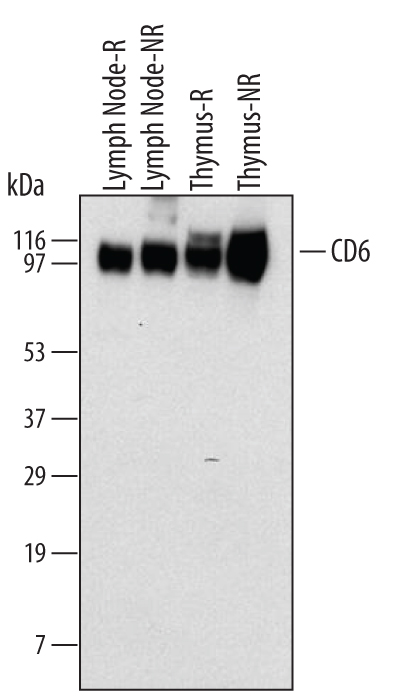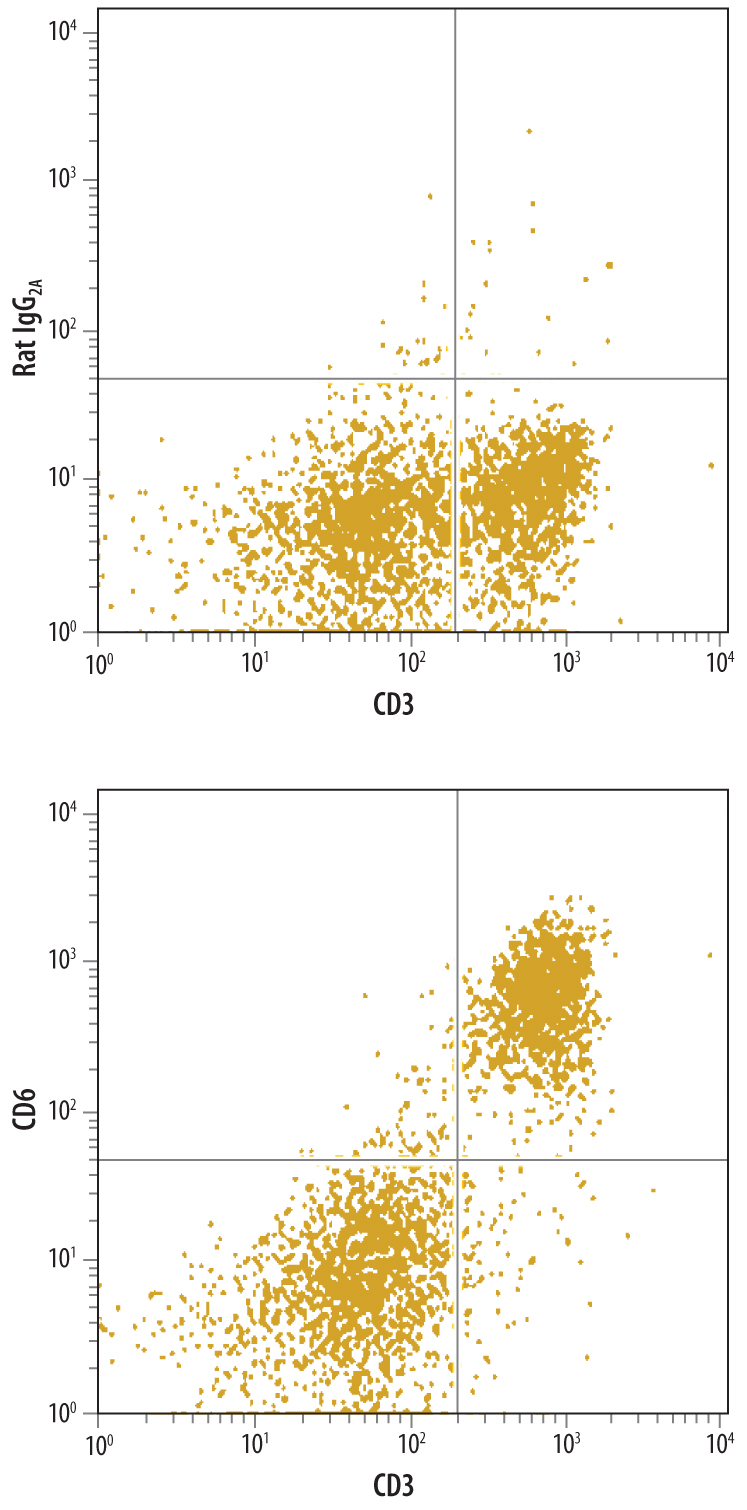Mouse CD6 Antibody Summary
Leu18-Gly396
Accession # Q61003
Applications
Please Note: Optimal dilutions should be determined by each laboratory for each application. General Protocols are available in the Technical Information section on our website.
Scientific Data
 View Larger
View Larger
 View Larger
View Larger
Detection of CD6 in Mouse Splenocytes by Flow Cytometry. Mouse splenocytes were stained with Rat Anti-Mouse CD6 Monoclonal Antibody (Catalog # MAB727) followed by Allophycocyanin-conjugated Anti-Rat IgG Secondary Antibody (Catalog # F0113) and Rat Anti-Mouse CD3 PE-conjugated Monoclonal Antibody (Catalog # FAB4841P). Quadrant markers were set based on control antibody staining (Catalog # MAB006).
Reconstitution Calculator
Preparation and Storage
- 12 months from date of receipt, -20 to -70 °C as supplied.
- 1 month, 2 to 8 °C under sterile conditions after reconstitution.
- 6 months, -20 to -70 °C under sterile conditions after reconstitution.
Background: CD6
CD6 is a member of the group B scavenger receptor cysteine-rich (SRCR) superfamily. CD6 is a type I membrane glycoprotein and contains three extracellular SRCR domains. CD6 is expressed at low levels on immature thymocytes and at high levels on mature thymocytes. The majority of peripheral blood T cells, a subset of B cells, and a subset of neuronal cells express CD6. Mouse CD6 is a 626 amino acid (aa) protein with a 24 aa signal sequence, a 372 aa extracellular domain, and a 204 aa cytoplasmic region. The 668 aa human homolog has also been identified. The human and murine proteins share 70% aa identity over their full-lengths.
The role of CD6 has not been fully elucidated. However, it appears to play a role as both a co-stimulatory molecule in T cell activation and as an adhesion receptor. Studies demonstrating a mitogenic effect for T cells with some CD6 specific monoclonal antibodies, in conjunction with either accessory cells or PMA and anti-CD2 mAb, support the concept of CD6 as a co-stimulatory molecule. Additionally, anti-CD6 monoclonal antibody has been used as an immunosuppressive agent for patients undergoing kidney or bone marrow allograft rejection. It has also been used to remove CD6+ T cells from donor bone marrow prior to allogenic bone marrow transplantation. Other studies have demonstrated an adhesive role for CD6, it has been demonstrated to bind the activated leukocyte cell adhesion molecule (ALCAM, CD166). CD6/ALCAM interactions have been postulated to play a role in thymocyte development. Additionally, the presence of ALCAM on neuronal cells may provide a mechanism of interaction between CD6+ T cell and ALCAM+ neuronal cells. Phosphorylation of the CD6 molecule appears to play a role in CD6-mediated signal transduction. Serine and threonine residues become hyperphosphorylated and tyrosine residues become phosphorylated when T cells are activated with anti-CD6 mAb in conjunction with PMA, anti-CD2, or anti-CD3 mAb. The CD6 intracellular domain contains regions that can interact with SH2 or SH3 containing proteins. However, the signaling pathways have not been elucidated.
- Gangemi, R. et al. (1989) J. Immunol. 143:2439.
- Aruffo, A. et al. (1991) J. Exp. Med. 174:949.
- Swack, J.A. et al. (1991) J. Biol. Chem. 266:7137.
- Robinson, W.H. et al. (1995) Eur. J. Immunol. 25:2765.
- Whitney, G. et al. (1995) Mol. Immunol. 32:89.
- Starling, G.C. et al. (1996) Eur. J. Immunol. 26:738.
- Degen, W.G. et al. (1998) Am. J. Pathol. 152:805.
- Swack, J.A. et al. (1989) Mol. Immunol. 26:1037.
- Pawelec, G. and H.J. Buhring (1991) Human Immunol. 31:165.
- Osorio, L.M. et al. (1995) Cell Immunol. 166:44.
- Robinson, W.H. et al. (1995) J. Immunol. 155:4739.
- Singer, N.G. et al. (1996) Immunology 88:537.
- Aruffo, A. et al. (1997) Immunol. Today 18:498.
Product Datasheets
FAQs
No product specific FAQs exist for this product, however you may
View all Antibody FAQsReviews for Mouse CD6 Antibody
There are currently no reviews for this product. Be the first to review Mouse CD6 Antibody and earn rewards!
Have you used Mouse CD6 Antibody?
Submit a review and receive an Amazon gift card.
$25/€18/£15/$25CAN/¥75 Yuan/¥2500 Yen for a review with an image
$10/€7/£6/$10 CAD/¥70 Yuan/¥1110 Yen for a review without an image

